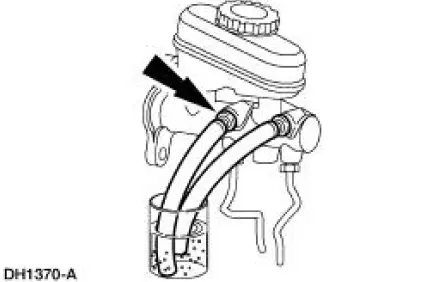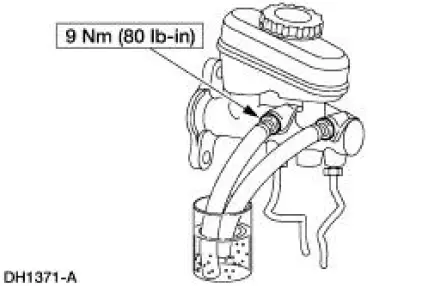Ford Mustang (1999-2004) Service Manual: Master Cylinder Priming - 4.6L
1. CAUTION: Use only bleed screws on the engine side of the brake master cylinder (2140). The hydro-boost bleed screw, located near the dash on the hydro-booster casting, is for the booster cavity filled with power steering fluid, not brake fluid.
Connect a clear waste line to the bleed screw closet to the booster first and the other end in a container partially filled with recommended brake fluid.

2. Open the bleeder screw, have an assistant push the brake pedal down slowly through full travel, close the bleeder screw, then return brake pedal slowly to full released position. Wait five seconds, then repeat operation until air bubbles cease to appear.
3. Repeat Step 2 for bleeder screw farthest from hydro-booster.

 Master Cylinder Priming - In-Vehicle or Bench
Master Cylinder Priming - In-Vehicle or Bench
WARNING: Brake fluid contains polyglycol ethers and polyglycols. Avoid
contact with
eyes. Wash hands thoroughly after handling. If brake fluid contacts eyes, flush
eyes with
running water for 15 min ...
 Four Wheel Anti-Lock Brake System (4WABS) Hydraulic Control Unit (HCU)
Four Wheel Anti-Lock Brake System (4WABS) Hydraulic Control Unit (HCU)
NOTE: This procedure only needs to be performed if the 4-wheel
anti-lock brake (4WABS) hydraulic
control unit (HCU) has been installed new or if the HCU lines have been
opened.
1. Clean all ...
Other materials:
Inspection and Verification
WARNING: Never remove the pressure relief cap while the engine is
operating or when the
cooling system is hot. Failure to follow these instructions can result in damage
to the cooling
system or engine or personal injury. To avoid having scalding hot coolant ...
Principles of Operation
The vehicle has two module communications networks. The standard
corporate protocol (SCP) which
is an unshielded twisted pair cable (data bus plus, Circuit 914 [TN/OG] and
data bus minus, Circuit 915
[PK/LB]), and the international standards organization ...
Supply Manifold
Removal and Installation
WARNING: Do not smoke or carry lighted tobacco or open flame of any
type when
working on or near any fuel related components. Highly flammable mixtures are
always present
and may ignite. Failure to follow these instructions may resul ...
